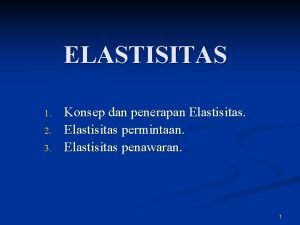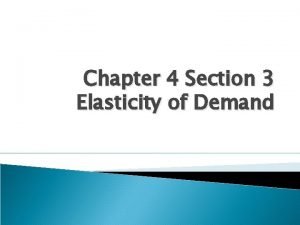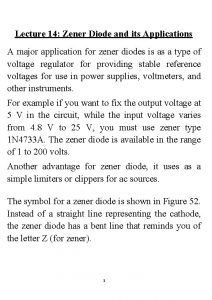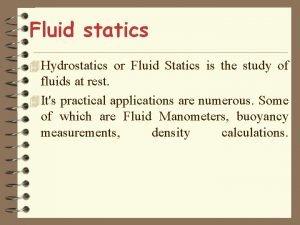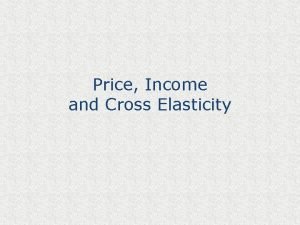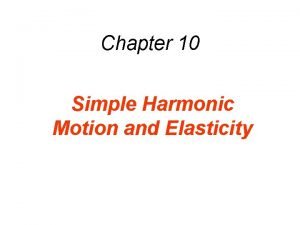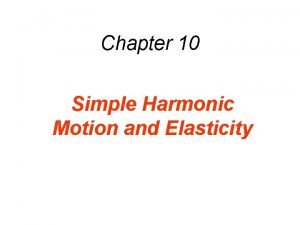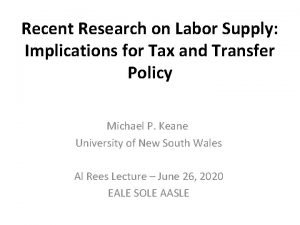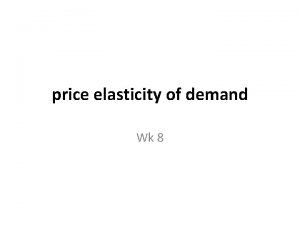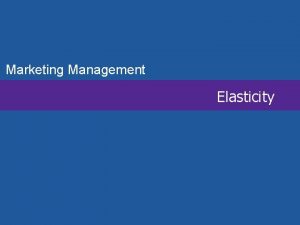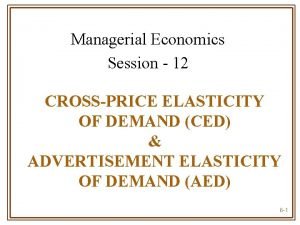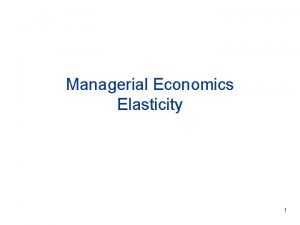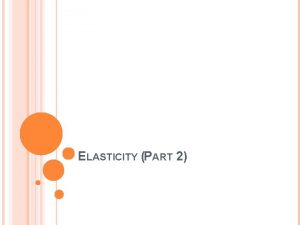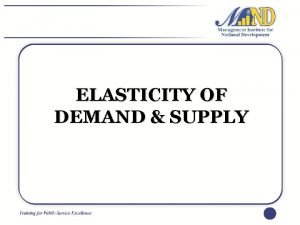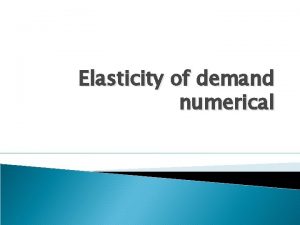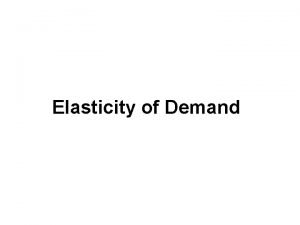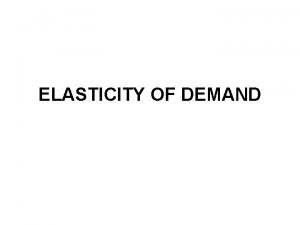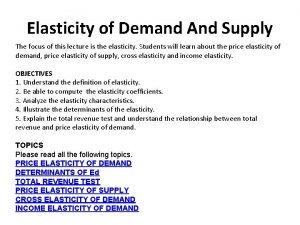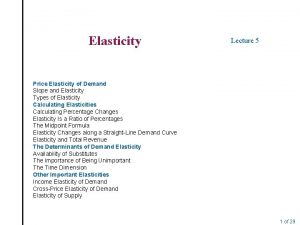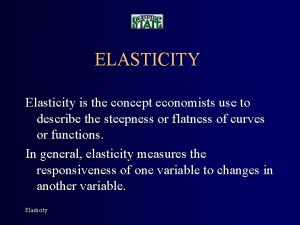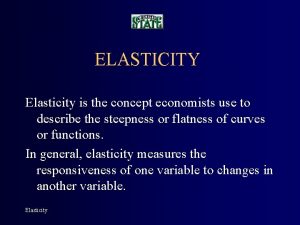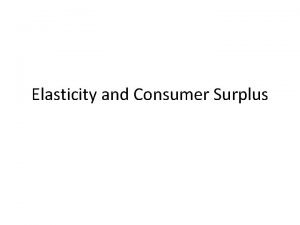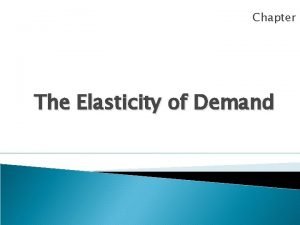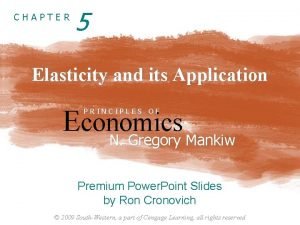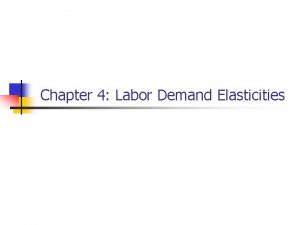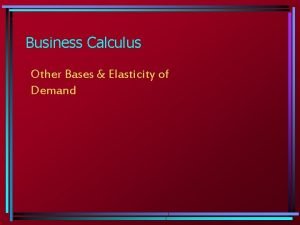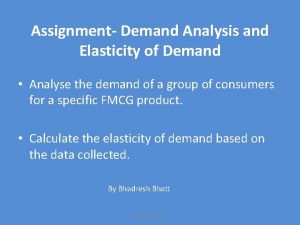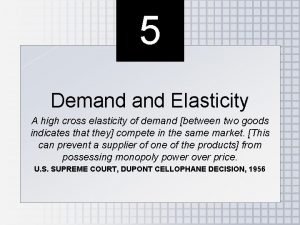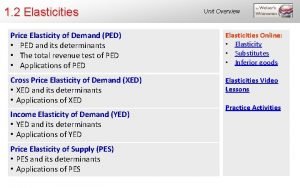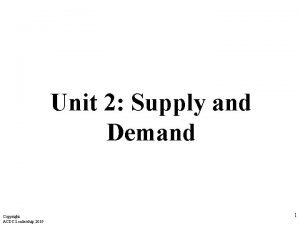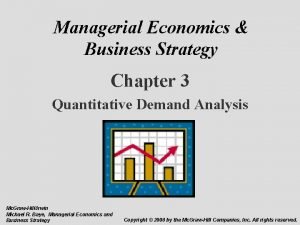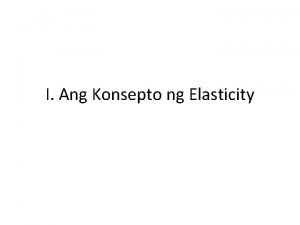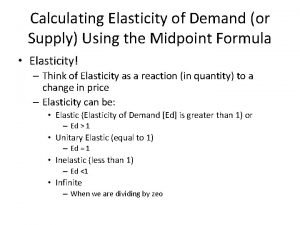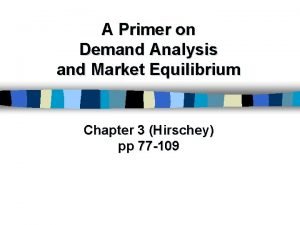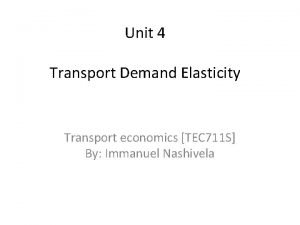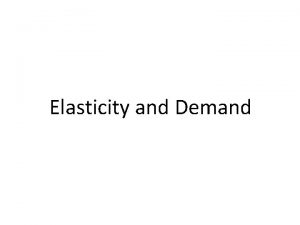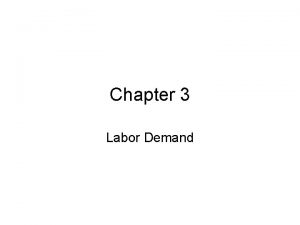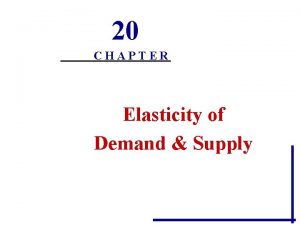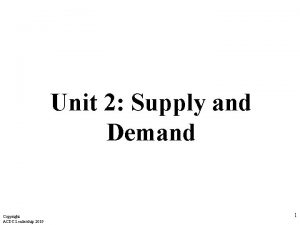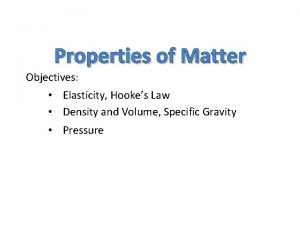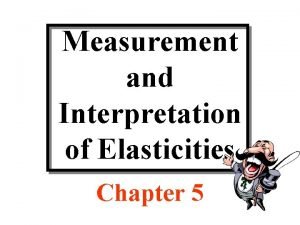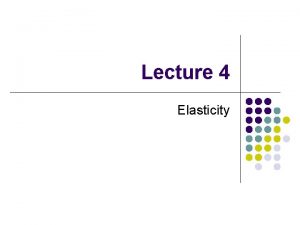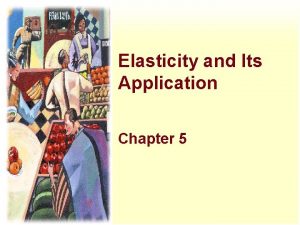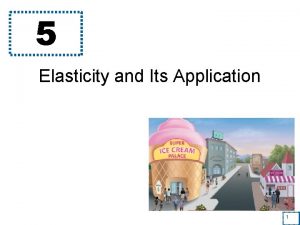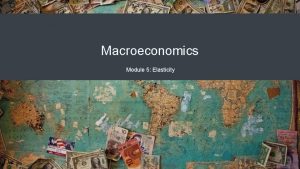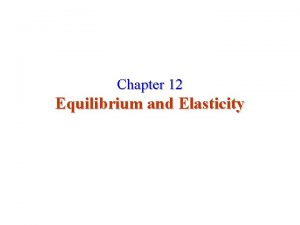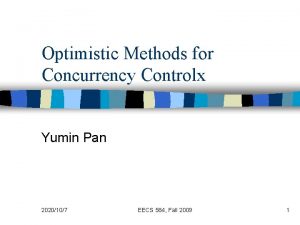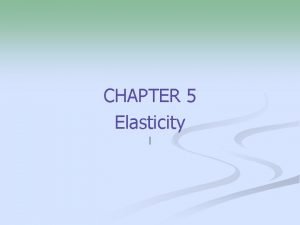Elasticity and Its Application Chapter 5 2020107 IN











































































- Slides: 75

Elasticity and Its Application Chapter 5 2020/10/7

IN THIS CHAPTER YOU WILL. . . 1. Learn the meaning of the elasticity of demand 2. Examine what determines the elasticity of demand 3. Learn the meaning of the elasticity of supply 4. Examine what determines the elasticity of supply 5. Apply the concept of elasticity in three very different markets Teacher: gulnur yusup 2020/10/7

Elasticity. . . … is a measure of how much buyers and sellers respond to changes in market conditions u … allows us to analyze supply and demand with greater precision. u Teacher: gulnur yusup 2020/10/7

Price Elasticity of Demand u Price elasticity of demand is the percentage change in quantity demanded given a percent change in the price. u It is a measure of how much the quantity demanded of a good responds to a change in the price of that good. Teacher: gulnur yusup 2020/10/7

Determinants of Price Elasticity of Demand u Necessities versus Luxuries u Availability of Close Substitutes u Definition of the Market u Time Horizon Teacher: gulnur yusup 2020/10/7

Determinants of Price Elasticity of Demand tends to be more elastic : u if the good is a luxury. u the longer the time period. u the larger the number of close substitutes. u the more narrowly defined the market. Teacher: gulnur yusup 2020/10/7

Computing the Price Elasticity of Demand The price elasticity of demand is computed as the percentage change in the quantity demanded divided by the percentage change in price. Page 72 Teacher: gulnur yusup 2020/10/7

Computing the Price Elasticity of Demand Example: If the price of an ice cream cone increases from $2. 00 to $2. 20 and the amount you buy falls from 10 to 8 cones then your elasticity of demand would be calculated as: Teacher: gulnur yusup 2020/10/7 Page 72

Computing the Price Elasticity of Demand Using the Midpoint Formula The midpoint formula is preferable when calculating the price elasticity of demand because it gives the same answer regardless of the direction of the change. Page 23 Teacher: gulnur yusup 2020/10/7

Computing the Price Elasticity of Demand Example: If the price of an ice cream cone increases from $2. 00 to $2. 20 and the amount you buy falls from 10 to 8 cones the your elasticity of demand, using the midpoint formula, would be calculated as: Teacher: gulnur yusup 2020/10/7

Ranges of Elasticity Inelastic Demand u. Quantity demanded does not respond strongly to price changes. u. Price elasticity of demand is less than one. Elastic Demand u. Quantity demanded responds strongly to changes in price. u. Price elasticity of demand is greater than one. Teacher: gulnur yusup 2020/10/7

Computing the Price Elasticity of Demand Price $5 4 Demand is price elastic 0 50 100 Quantity Chapter 5, figure 1, page 74 Teacher: gulnur yusup 2020/10/7

Ranges of Elasticity u Perfectly Inelastic Quantity demanded does not respond to price changes. u Perfectly Elastic Quantity demanded changes infinitely with any change in price. u Unit Elastic Quantity demanded changes by the same percentage as the price. Teacher: gulnur yusup 2020/10/7

A Variety of Demand Curves Because the price elasticity of demand measures how much quantity demanded responds to the price, it is closely related to the slope of the demand curve. Teacher: gulnur yusup 2020/10/7

Perfectly Inelastic Demand - Elasticity equals 0 Price Demand 1. An $5 increase in price. . . 4 Quantity 100 2. . leaves the quantity demanded unchanged. Teacher: gulnur yusup 2020/10/7 Chapter 5, figure 1, page 74

Inelastic Demand - Elasticity is less than 1 Price 1. A 22%$5 increase in price. . . 4 Demand Quantity 90 100 2. . leads to a 11% decrease in quantity. Teacher: gulnur yusup Chapter 5, figure 2020/10/7 1, page 74

Unit Elastic Demand - Elasticity equals 1 Price 1. A 22%$5 increase in price. . . 4 Demand Quantity 80 100 2. . leads to a 22% decrease in quantity. Teacher: gulnur yusup 2020/10/7 Chapter 5, figure 1, page 74

Elastic Demand - Elasticity is greater than 1 Price 1. A 22%$ increase 5 in price. . . 4 Demand Quantity 50 100 2. . leads to a 67% decrease in quantity. Teacher: gulnur yusup 2020/10/7 Chapter 5, figure 1, page 74

Perfectly Elastic Demand - Elasticity equals infinity Price 1. At any price above $4, quantity demanded is zero. Demand $4 2. At exactly $4, consumers will buy any quantity. 3. At a price below $4, quantity demanded is infinite. Teacher: gulnur yusup Quantity 2020/10/7 Chapter 5, figure 1, page 74

Elasticity and Total Revenue u Total revenue is the amount paid by buyers and received by sellers of a good. u Computed as the price of the good times the quantity sold. TR = P x Q Teacher: gulnur yusup 2020/10/7

Elasticity and Total Revenue Price $4 P x Q = $400 (total revenue) P 0 Q Demand 100 Teacher: gulnur yusup Quantit 2020/10/7

Elasticity and Total Revenue With an inelastic demand curve, an increase in price leads to a decrease in quantity that is proportionately smaller. Thus, total revenue increases. Teacher: gulnur yusup 2020/10/7

Elasticity and Total Revenue: Inelastic Demand Price An increase in price from $1 to $3. . . …leads to an increase in total revenue from$100 to $240 $3 Revenue = $240 $1 0 Revenue = $100 Demand 100 Quantity 0 Teacher: gulnur yusup Demand 80 2020/10/7 Quantity

Elasticity and Total Revenue With an elastic demand curve, an increase in the price leads to a decrease in quantity demanded that is proportionately larger. Thus, total revenue decreases. Teacher: gulnur yusup 2020/10/7

Elasticity and Total Revenue: Elastic Demand Price An increase in price from $4 to $5. . . …leads to a decrease in total revenue from$200 to $100 Price $5 $4 Demand Revenue = $200 0 50 Quantity Revenue = $100 0 Teacher: gulnur yusup 20 Quantity 2020/10/7

Computing the Elasticity of a Linear Demand Curve Teacher: gulnur yusup 2020/10/7

Income Elasticity of Demand u Income elasticity of demand measures how much the quantity demanded of a good responds to a change in consumers’ income. u It is computed as the percentage change in the quantity demanded divided by the percentage change in income. Teacher: gulnur yusup 2020/10/7

Computing Income Elasticity = of Demand Percentage Change in Quantity Demanded Percentage Change in Income Teacher: gulnur yusup 2020/10/7

Income Elasticity - Types of Goods u Normal Goods u Inferior Goods u Higher income raises the quantity demanded for normal goods but lowers the quantity demanded for inferior goods. Teacher: gulnur yusup 2020/10/7

Income Elasticity - Types of Goods u Goods consumers regard as necessities tend to be income inelastic Examples include food, fuel, clothing, utilities, and medical services. u Goods consumers regard as luxuries tend to be income elastic. Examples include sports cars, furs, and expensive foods. Teacher: gulnur yusup 2020/10/7

Cross-price elasticity of demand Measures how much quantity demanded of one good changes as the price of another good changes. Cross-price elasticity of demand Percentage change in quantity demanded of good 1 Percentage change in the price of good 2 Teacher: gulnur yusup 2020/10/7

Price Elasticity of Supply u Price elasticity of supply is the percentage change in quantity supplied resulting from a percent change in price. u It is a measure of how much the quantity supplied of a good responds to a change in the price of that good. Teacher: gulnur yusup 2020/10/7

Ranges of Elasticity u Perfectly Elastic ES = ¥ u Relatively Elastic ES > 1 u Unit Elastic ES = 1 Teacher: gulnur yusup 2020/10/7

Ranges of Elasticity u Relatively Inelastic ES < 1 u Perfectly Inelastic ES = 0 Teacher: gulnur yusup 2020/10/7

Perfectly Inelastic Supply - Elasticity equals 0 Price Supply 1. An $5 increase in price. . . 4 Quantity 100 2. . leaves the quantity supplied unchanged. Teacher: gulnur yusup 2020/10/7 Chapter 5, figure 2, page 79

Inelastic Supply - Elasticity is less than 1 Price Supply 1. A 22%$5 increase in price. . . 4 Quantity 100 110 2. . leads to a 10% increase in quantity. Teacher: gulnur yusup 2020/10/7 Chapter 5, figure 2, page 79

Unit Elastic Supply - Elasticity equals 1 Price Supply 1. A 22%$5 increase in price. . . 4 Quantity 100 125 2. . leads to a 22% increase in quantity. Teacher: gulnur yusup 2020/10/7 Chapter 5, figure 2, page 79

Elastic Supply - Elasticity is greater than 1 Price Supply 1. A 22%$5 increase in price. . . 4 100 200 Quantity 2. . leads to a 67% increase in quantity. Teacher: gulnur yusup 2020/10/7 Chapter 5, figure 2, page 79

Perfectly Elastic Supply - Elasticity equals infinity Price 1. At any price above $4, quantity supplied is infinite. Supply $4 2. At exactly $4, producers will supply any quantity. 3. At a price below $4, quantity supplied is zero. Teacher: gulnur yusup Quantity 2020/10/7 Chapter 5, figure 2, page 79

Determinants of Elasticity of Supply u. Ability of sellers to change the amount of the good they produce. u Beach-front land is inelastic. u Books, cars, or manufactured goods are elastic. u. Time period. u. Supply is more elastic in the long run. Teacher: gulnur yusup 2020/10/7

Computing the Price Elasticity of Supply The price elasticity of supply is computed as the percentage change in the quantity supplied divided by the percentage change in price. Teacher: gulnur yusup 2020/10/7 Chapter 5, page 78

Application of Elasticity u. Can good news for farming be bad news for farmers? u. What happens to wheat farmers and the market for wheat when university agronomists discover a new wheat hybrid that is more productive than existing varieties? Teacher: gulnur yusup 2020/10/7

Application of Elasticity In this case, the discovery of the new hybrid affects the supply curve. Because the hybrid increases the amount of wheat that can be produced on each acre of land, farmers are now willing to supply more wheat at any given price. In other words, the supply curve shifts to the right. The demand curve remains the same because consumers’ desire to buy wheat products at any given price is not affected by the introduction Teacher: gulnur yusup 2020/10/7

of a new hybrid. When the supply curve shifts from S 1 to S 2, the quantity of wheat sold increases from 100 to 110, and the price of wheat falls from $3 to $2. But does this discovery make farmers better off? As a first cut to answering this question, consider what happens to the total revenue received by farmers. Farmers’ total revenue is PQ, the price of the wheat times the quantity sold. Teacher: gulnur yusup 2020/10/7

. An Increase in Supply in the Market for Wheat Price of Wheat S 1 $3 Demand 0 100 Chapter 5, figure 4, page 82 Quantity of Wheat

. An Increase in Supply in the Market for Wheat Price of Wheat 1. When demand is inelast an increase in supply. . . S 1 2. . leads$3 to a large 2 fall in price. . . S 2 Chapter 5, figure 4, page 82 Demand 0 100 110 Quantity of Wheat 3. . and a proportionately smaller increase in quantity sold. As a resu revenue falls from $300 to $220.

Compute Elasticity Demand is inelastic Teacher: gulnur yusup 2020/10/7

The hybrid allows farmers to produce more wheat (Q rises), but now each bushel of wheat sells for less (P falls). Whether total revenue rises or falls depends on the elasticity of demand. In practice, the demand for basic foodstuffs such as wheat is usually inelastic, for these items are relatively inexpensive and have few good substitutes. When the demand curve is inelastic, a decrease in price causes total revenue to fall. Teacher: gulnur yusup 2020/10/7

in order to produce and sell more wheat. Yet when all farmers do this, the supply of wheat rises, the price falls, and farmers are worse off. Although this example may at first seem only hypothetical, in fact it helps to explain a major change in the U. S. economy over the past century. Two hundred years ago, most Americans lived on farms. Knowledge about farm methods was sufficiently primitive that most of us had to be farmers to produce enough food. Yet, over time, advances in farm technology increased the amount of food that each farmer could produce. This increase in food supply, together with inelastic food demand, caused farm revenues to fall, which in turn encouraged people to leave farming. Teacher: gulnur yusup 2020/10/7

A few numbers show the magnitude of this historic change. As recently as 1950, there were 10 million people working on farms in the United States, representing 17 percent of the labor force. In 1998, fewer than 3 million people worked on farms, or 2 percent of the labor force. This change coincided with tremendous advances in farm productivity: Despite the 70 percent drop in the number of farmers, U. S. farms produced more than twice the output of crops and livestock in 1998 as they did in 1950. Teacher: gulnur yusup 2020/10/7

This analysis of the market for farm products also helps to explain a seeming paradox of public policy: Certain farm programs try to help farmers by inducing them not to plant crops on all of their land. Why do these programs do this? Their purpose is to reduce the supply of farm products and thereby raise prices. With inelastic demand for their products, farmers as a group receive greater total revenue if they supply a smaller crop to the market. No single farmer would choose to leave his land fallow on his own because each takes the market price as given. But if all farmers do so together, each of them can be better off. Teacher: gulnur yusup 2020/10/7

The price of wheat falls substantially, whereas the quantity of wheat sold rises only slightly. Total revenue falls from $300 to $220. Thus, the discovery of the new hybrid lowers the total revenue that farmers receive for the sale of their crops. If farmers are made worse off by the discovery of this new hybrid, why do they adopt it? The answer to this question goes to the heart of how competitive markets work. Because each farmer is a small part of the market for wheat, he or she takes the price of wheat as given. For any given price of wheat, it is better to use the new hybrid Teacher: gulnur yusup 2020/10/7

Teacher: gulnur yusup 2020/10/7

Teacher: gulnur yusup 2020/10/7

When analyzing the effects of farm technology or farm policy, it is important to keep in mind that what is good for farmers is not necessarily good for society as a whole. Improvement in farm technology can be bad for farmers who become increasingly unnecessary, but it is surely good for consumers who pay less for food. Similarly, a policy aimed at reducing the supply of farm products may raise the incomes of farmers, but it does so at the expense of consumers. Teacher: gulnur yusup 2020/10/7

Application of Elasticity u Examine whether the supply or demand curve shifts. u Determine the direction of the shift of the curve. u Use the supply-and-demand diagram to see how the market equilibrium changes. Teacher: gulnur yusup 2020/10/7

Summary u. Price elasticity of demand measures how much the quantity demanded responds to changes in the price. u. If a demand curve is elastic, total revenue falls when the price rises. u. If it is inelastic, total revenue rises as the price rises. Teacher: gulnur yusup 2020/10/7

Summary u. The price elasticity of supply measures how much the quantity supplied responds to changes in the price. u. In most markets, supply is more elastic in the long run than in the short run. Teacher: gulnur yusup 2020/10/7

Graphical Review Teacher: gulnur yusup 2020/10/7

Computing the Price Elasticity of Demand Price $5 4 Demand is price elastic 0 50 100 Quantity Teacher: gulnur yusup 2020/10/7

Perfectly Inelastic Demand - Elasticity equals 0 Price Demand 1. An $5 increase in price. . . 4 Quantity 100 2. . leaves the quantity demanded unchanged. Teacher: gulnur yusup 2020/10/7

Inelastic Demand - Elasticity is less than 1 Price 1. A 22%$5 increase in price. . . 4 Demand Quantity 90 100 2. . leads to a 11% decrease in quantity. Teacher: gulnur yusup 2020/10/7

Unit Elastic Demand - Elasticity equals 1 Price 1. A 22%$5 increase in price. . . 4 Demand Quantity 80 100 2. . leads to a 22% decrease in quantity. Teacher: gulnur yusup 2020/10/7

Elastic Demand - Elasticity is greater than 1 Price 1. A 22%$ increase 5 in price. . . 4 Demand Quantity 50 100 2. . leads to a 67% decrease in quantity. Teacher: gulnur yusup 2020/10/7

Perfectly Elastic Demand - Elasticity equals infinity Price 1. At any price above $4, quantity demanded is zero. Demand $4 2. At exactly $4, consumers will buy any quantity. 3. At a price below $4, quantity demanded is infinite. Teacher: gulnur yusup Quantity 2020/10/7

Elasticity and Total Revenue Price $4 P x Q = $400 (total revenue) P 0 Q Demand 100 Teacher: gulnur yusup Quantit 2020/10/7

Elasticity and Total Revenue: Inelastic Demand Price An increase in price from $1 to $3. . . …leads to an increase in total revenue from$100 to $240 $3 Revenue = $240 $1 0 Revenue = $100 Demand 100 Quantity 0 Teacher: gulnur yusup Demand 80 2020/10/7 Quantity

Elasticity and Total Revenue: Elastic Demand Price An increase in price from $4 to $5. . . …leads to a decrease in total revenue from$200 to $100 Price $5 $4 Demand Revenue = $200 0 50 Quantity Revenue = $100 0 Teacher: gulnur yusup 20 Quantity 2020/10/7

Perfectly Inelastic Supply - Elasticity equals 0 Price Supply 1. An $5 increase in price. . . 4 Quantity 100 2. . leaves the quantity supplied unchanged. Teacher: gulnur yusup 2020/10/7

Inelastic Supply - Elasticity is less than 1 Price Supply 1. A 22%$5 increase in price. . . 4 Quantity 100 110 2. . leads to a 10% increase in quantity. Teacher: gulnur yusup 2020/10/7

Unit Elastic Supply - Elasticity equals 1 Price Supply 1. A 22%$5 increase in price. . . 4 Quantity 100 125 2. . leads to a 22% increase in quantity. Teacher: gulnur yusup 2020/10/7

Elastic Supply - Elasticity is greater than 1 Price Supply 1. A 22%$5 increase in price. . . 4 100 200 Quantity 2. . leads to a 67% increase in quantity. Teacher: gulnur yusup 2020/10/7

Perfectly Elastic Supply - Elasticity equals infinity Price 1. At any price above $4, quantity supplied is infinite. Supply $4 2. At exactly $4, producers will supply any quantity. 3. At a price below $4, quantity supplied is zero. Teacher: gulnur yusup Quantity 2020/10/7

. An Increase in Supply in the Market for Wheat Price of Wheat S 1 $3 Demand 0 100 Quantity of Wheat

. An Increase in Supply in the Market for Wheat Price of Wheat 1. When demand is inelast an increase in supply. . . S 1 S 2 2. . leads$3 to a large 2 fall in price. . . Demand 0 100 110 Quantity of Wheat 3. . and a proportionately smaller increase in quantity sold. As a resu revenue falls from $300 to $220.
 Chapter 5 elasticity and its application multiple choice
Chapter 5 elasticity and its application multiple choice Permintaan elastis uniter terjadi jika nilai ed. . ...
Permintaan elastis uniter terjadi jika nilai ed. . ... Midpoint formula economics
Midpoint formula economics Application of elasticity
Application of elasticity Wheelchair physics
Wheelchair physics Chapter 4 section 3 elasticity of demand answers
Chapter 4 section 3 elasticity of demand answers Chapter 4 lesson 3 elasticity of demand
Chapter 4 lesson 3 elasticity of demand Chapter 4 section 3 elasticity of demand
Chapter 4 section 3 elasticity of demand Static equilibrum
Static equilibrum Advantages of zener diode
Advantages of zener diode Examples of fluid statics
Examples of fluid statics Emigree poem annotated
Emigree poem annotated Its halloween its halloween the moon is full and bright
Its halloween its halloween the moon is full and bright When a train increases its velocity, its momentum
When a train increases its velocity, its momentum Cloudy windy rainy sunny
Cloudy windy rainy sunny If its square its a sonnet
If its square its a sonnet Its not easy but its worth it
Its not easy but its worth it Price and income elasticity
Price and income elasticity Elasticity and oscillations
Elasticity and oscillations Price and income elasticity
Price and income elasticity Simple harmonic motion and elasticity
Simple harmonic motion and elasticity Simple harmonic motion and elasticity
Simple harmonic motion and elasticity Damped oscillation
Damped oscillation Compliance elastance
Compliance elastance Elasticity of labor supply
Elasticity of labor supply Cross-price elasticity of demand formula
Cross-price elasticity of demand formula How to measure elasticity
How to measure elasticity Formula for elasticity of demand
Formula for elasticity of demand Promotional elasticity of demand
Promotional elasticity of demand Promotional elasticity of demand
Promotional elasticity of demand Yedyed
Yedyed What are the 5 determinants of price elasticity of demand
What are the 5 determinants of price elasticity of demand Objectives of elasticity of demand
Objectives of elasticity of demand Total expenditure method
Total expenditure method Arc method of elasticity of demand
Arc method of elasticity of demand Degree of elasticity of demand
Degree of elasticity of demand Demand analysis example
Demand analysis example Elasticity measures
Elasticity measures How to calculate quantity demanded
How to calculate quantity demanded Facts about elasticity
Facts about elasticity Midpoint formula elasticity
Midpoint formula elasticity Midpoint method price elasticity of demand
Midpoint method price elasticity of demand Why is elasticity of demand negative
Why is elasticity of demand negative Unitary elastic.
Unitary elastic. Downward sloping demand curve
Downward sloping demand curve Marginal revenue formula
Marginal revenue formula Arc elasticity of demand
Arc elasticity of demand The own-wage elasticity of demand measures
The own-wage elasticity of demand measures Elasticity of demand formula calculus
Elasticity of demand formula calculus Elasticity of demand
Elasticity of demand Ped
Ped High cross elasticity of demand
High cross elasticity of demand Cross-price elasticity of demand formula
Cross-price elasticity of demand formula Acdc economics elasticity
Acdc economics elasticity What is elasticity
What is elasticity Own price elasticity
Own price elasticity Scalability vs elasticity
Scalability vs elasticity Mga halimbawa ng programang pang edukasyon
Mga halimbawa ng programang pang edukasyon What is elasticity
What is elasticity Elasticity mind map
Elasticity mind map Guided reading 4-3 elasticity of demand answers
Guided reading 4-3 elasticity of demand answers Cross elasticity of demand midpoint formula
Cross elasticity of demand midpoint formula Own price elasticity
Own price elasticity Elasticity in transportation
Elasticity in transportation Elasticity partial derivative
Elasticity partial derivative Elasticity of demand formula
Elasticity of demand formula Hooke's law mathematical expression
Hooke's law mathematical expression Elasticity of demand formula
Elasticity of demand formula Elasticity examples
Elasticity examples Elasticity of substitution
Elasticity of substitution Price elasticity of supply measures how responsive
Price elasticity of supply measures how responsive Acdc economics elasticity
Acdc economics elasticity Properties of matter elasticity
Properties of matter elasticity Why is elasticity of demand negative
Why is elasticity of demand negative Elasticity interpretation
Elasticity interpretation Elasticity
Elasticity

